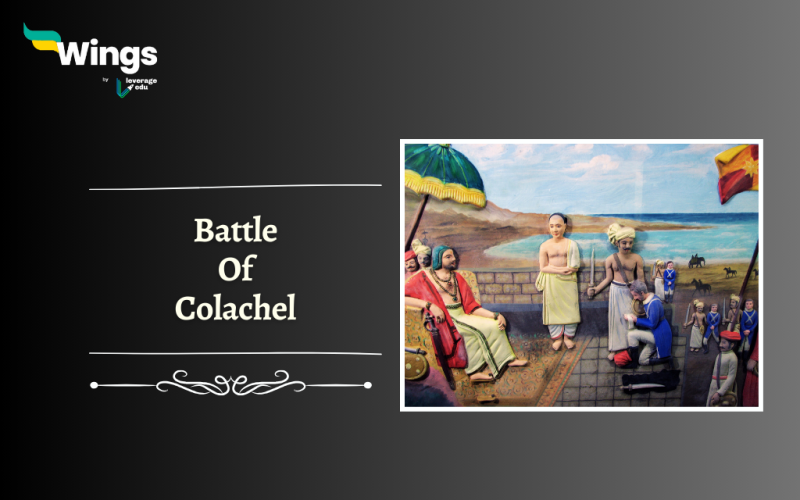The Battle of Colachel aka Kulachal was fought in the August of 1741. It was fought between the Dutch East India Company and the Kingdom of Travancore. The battle is said to have resulted in a decisive victory for the Travancore army, marking the end to the colonial Dutch rule in the Indian Sub-continent and showcasing the combined power of Asian power over European forces. Scroll further down to get to know more about the battle of Colachel in this blog.
Table of Contents [show]
| Battle of Colachel Overview | |
| Battle Took Place On | August, 1741 |
| Place | Colachel |
| Fought Between | Travancore ruler Vs Dutch East India Company |
| Won By | King of Travancore |
Background Of The Battle
Kerala during the early 18th century was made up of many small kingdoms that were in a constant state of war with each other.
- In the 1730s, Marthanda Verma, the new ruler of Travancore decided to pursue a policy of expansionism.
- He successfully conquered several small kingdoms in Malabar that posed a threat to the economic interests of the Dutch East India Company.
- This was because Marthanda Varma and his supporters had little to no interest in upholding the contracts that the Dutch had previously made with the conquered states.
- In an attempt to safeguard Dutch trade in Malabar, Governor Gustaaf Willem van Imhoff who visited Kochi and proposed a military alliance with the neighbouring kingdoms of Travancore such as Kochi, Kollam and Kayamkulam.
- However, negotiations between Van Imhoff and Marthanda Varma to resolve the issue peacefully failed, with Varma dismissing the Dutch threat of war.
- In late 1739, the Dutch army, along with their allies, declared war on Travancore and achieved several victories, forcing the Travancore forces to retreat.
- The British East India Company also sent its 150 men to support the Dutch forces.
- The Dutch army advanced towards Attingal, seizing the opportunity presented by the Travancore army’s withdrawal because of an invasion by Arcot in the south.
- Although the Dutch required reinforcements from their base in Indonesia, local uprisings there made it difficult. Despite this, reinforcements arrived from Sri Lanka, which led to the Battle of Colachel.
Also Read – Battle of Plassey: History, Context, and Legacy
Siege of Colachel
In November 1740, the Dutch also launched a naval attack on Colachel, causing the town’s inhabitants to run away. In retaliation, Marthanda Varma sent a 2,000 people force to Colachel. The Dutch, however, aimed to siege Colachel and then move on to Padmanabhapuram, the capital of Travancore. Following their capture of Colachel, the Dutch proceeded to loot the villages nearby and also the region between Kottar and Colachel.
- After the Dutch requested reinforcements from Sri Lanka and Indonesia, only around 300-400 men from Ceylon arrived due to the ongoing rebellion in Indonesia.
- Taking the opportunity of the shortage of Dutch troops, Marthanda Verma attacked Colachel with a 1,000-strong army and surrounded the Dutch.
- However, despite the numerical advantage, the Europeans had better technology and inflicted casualties on the Travancore army.
- The Dutch were unable to receive supplies due to adverse weather conditions such as rains and floods, and their gunpowder became damp, rendering them unable to put up much resistance.
- Finally, on August 5, 1741, a cannonball hit a barrel of gunpowder inside the Dutch garrison, destroying the ammunition and food stores.
- With no resources left to fight, the Dutch surrendered on August 7 (although some historians consider August 10 as the official date of surrender).
Outcome Of The Battle
As a result of the Battle of Colachel, Dutch trade in Kerala eventually came to an end. Although it did not immediately settled the Travancore-Dutch war, the defeat had a demoralizing effect on the Dutch forces, which made the native chiefs realize that the Dutch could be defeated.
What followed was huge, as Dutch prisoners also offered their services to modernize the Travancore army in the European way. The trained Travancore army turned out to be highly effective in Marthanda Varma’s wars against different other kingdoms of Kerala. This army went on to conquer most of modern-day Kerala. Additionally, the forts designed by De Lannoy proved to be effective in stalling the advancement of the French-armed Mysorean army in 1791.
Relevant Blogs
This was all about the Battle of Colachel. For more content related to the different states of India, visit our articles like this, you can get Study notes on the Modern History of India here. Also, you can visit our general knowledge page on Indian History!
 One app for all your study abroad needs
One app for all your study abroad needs















 45,000+ students trusted us with their dreams. Take the first step today!
45,000+ students trusted us with their dreams. Take the first step today!
